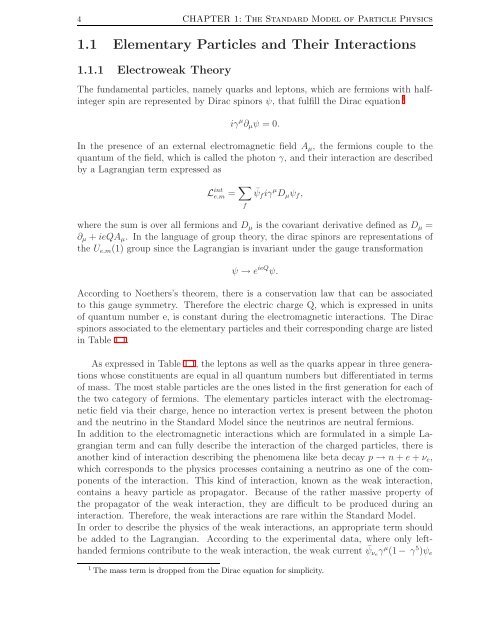Measurement of the Jet Energy Scale in the CMS experiment ... - IIHE
Measurement of the Jet Energy Scale in the CMS experiment ... - IIHE
Measurement of the Jet Energy Scale in the CMS experiment ... - IIHE
Create successful ePaper yourself
Turn your PDF publications into a flip-book with our unique Google optimized e-Paper software.
4 CHAPTER 1: The Standard Model <strong>of</strong> Particle Physics1.1 Elementary Particles and Their Interactions1.1.1 Electroweak TheoryThe fundamental particles, namely quarks and leptons, which are fermions with half<strong>in</strong>tegersp<strong>in</strong> are represented by Dirac sp<strong>in</strong>ors ψ, that fulfill <strong>the</strong> Dirac equation 1iγ µ ∂ µ ψ = 0.In <strong>the</strong> presence <strong>of</strong> an external electromagnetic field A µ , <strong>the</strong> fermions couple to <strong>the</strong>quantum <strong>of</strong> <strong>the</strong> field, which is called <strong>the</strong> photon γ, and <strong>the</strong>ir <strong>in</strong>teraction are describedby a Lagrangian term expressed asL <strong>in</strong>te.m = ∑ f¯ψ f iγ µ D µ ψ f ,where <strong>the</strong> sum is over all fermions and D µ is <strong>the</strong> covariant derivative def<strong>in</strong>ed as D µ =∂ µ + ieQA µ . In <strong>the</strong> language <strong>of</strong> group <strong>the</strong>ory, <strong>the</strong> dirac sp<strong>in</strong>ors are representations <strong>of</strong><strong>the</strong> U e.m (1) group s<strong>in</strong>ce <strong>the</strong> Lagrangian is <strong>in</strong>variant under <strong>the</strong> gauge transformationψ → e ieQ ψ.Accord<strong>in</strong>g to Noe<strong>the</strong>rs’s <strong>the</strong>orem, <strong>the</strong>re is a conservation law that can be associatedto this gauge symmetry. Therefore <strong>the</strong> electric charge Q, which is expressed <strong>in</strong> units<strong>of</strong> quantum number e, is constant dur<strong>in</strong>g <strong>the</strong> electromagnetic <strong>in</strong>teractions. The Diracsp<strong>in</strong>ors associated to <strong>the</strong> elementary particles and <strong>the</strong>ir correspond<strong>in</strong>g charge are listed<strong>in</strong> Table 1.1.As expressed <strong>in</strong> Table 1.1, <strong>the</strong> leptons as well as <strong>the</strong> quarks appear <strong>in</strong> three generationswhose constituents are equal <strong>in</strong> all quantum numbers but differentiated <strong>in</strong> terms<strong>of</strong> mass. The most stable particles are <strong>the</strong> ones listed <strong>in</strong> <strong>the</strong> first generation for each <strong>of</strong><strong>the</strong> two category <strong>of</strong> fermions. The elementary particles <strong>in</strong>teract with <strong>the</strong> electromagneticfield via <strong>the</strong>ir charge, hence no <strong>in</strong>teraction vertex is present between <strong>the</strong> photonand <strong>the</strong> neutr<strong>in</strong>o <strong>in</strong> <strong>the</strong> Standard Model s<strong>in</strong>ce <strong>the</strong> neutr<strong>in</strong>os are neutral fermions.In addition to <strong>the</strong> electromagnetic <strong>in</strong>teractions which are formulated <strong>in</strong> a simple Lagrangianterm and can fully describe <strong>the</strong> <strong>in</strong>teraction <strong>of</strong> <strong>the</strong> charged particles, <strong>the</strong>re isano<strong>the</strong>r k<strong>in</strong>d <strong>of</strong> <strong>in</strong>teraction describ<strong>in</strong>g <strong>the</strong> phenomena like beta decay p → n + e + ν e ,which corresponds to <strong>the</strong> physics processes conta<strong>in</strong><strong>in</strong>g a neutr<strong>in</strong>o as one <strong>of</strong> <strong>the</strong> components<strong>of</strong> <strong>the</strong> <strong>in</strong>teraction. This k<strong>in</strong>d <strong>of</strong> <strong>in</strong>teraction, known as <strong>the</strong> weak <strong>in</strong>teraction,conta<strong>in</strong>s a heavy particle as propagator. Because <strong>of</strong> <strong>the</strong> ra<strong>the</strong>r massive property <strong>of</strong><strong>the</strong> propagator <strong>of</strong> <strong>the</strong> weak <strong>in</strong>teraction, <strong>the</strong>y are difficult to be produced dur<strong>in</strong>g an<strong>in</strong>teraction. Therefore, <strong>the</strong> weak <strong>in</strong>teractions are rare with<strong>in</strong> <strong>the</strong> Standard Model.In order to describe <strong>the</strong> physics <strong>of</strong> <strong>the</strong> weak <strong>in</strong>teractions, an appropriate term shouldbe added to <strong>the</strong> Lagrangian. Accord<strong>in</strong>g to <strong>the</strong> <strong>experiment</strong>al data, where only lefthandedfermions contribute to <strong>the</strong> weak <strong>in</strong>teraction, <strong>the</strong> weak current ¯ψ νe γ µ (1 − γ 5 )ψ e1 The mass term is dropped from <strong>the</strong> Dirac equation for simplicity.
















